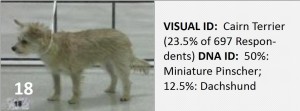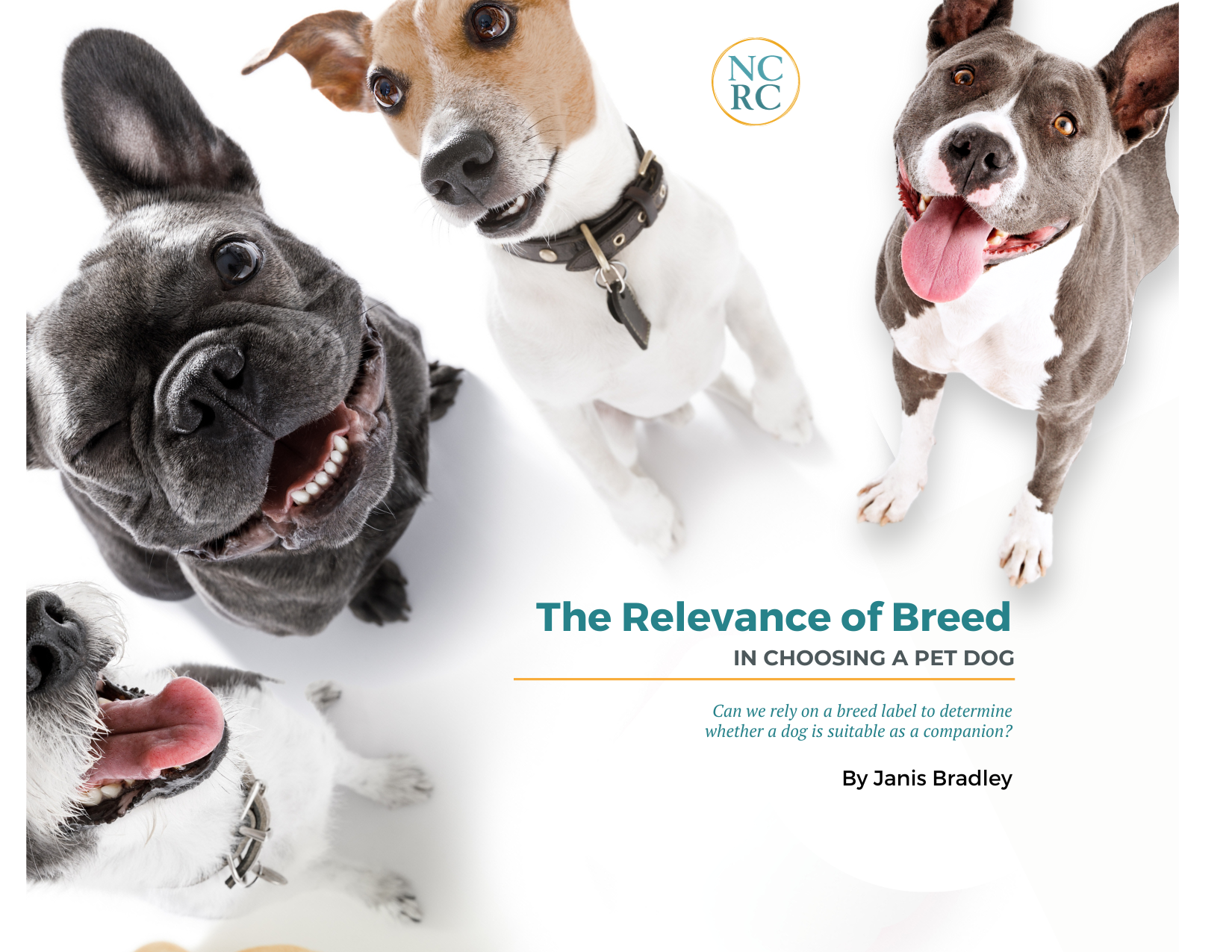Summary
A survey of more than 900 people in dog-related professions and services showed that they frequently disagreed with each other when making visual breed identifications of the same dog, and that their opinions may or may not have correlated with DNA breed analysis. More than 70% of the study participants reported that now, or at one time, their breed descriptors were used in record keeping. The results of this survey call into question the validity of a variety of data that has been collected over the decades pertaining to breed identification of dogs.
Introduction
In 1965, John Paul Scott and John L. Fuller published a series of photographs showing cross-bred dogs who bore little, if any, resemblance to their purebred ancestors. [1]
Dr. Victoria Voith of Western University of Health Sciences has taken up the question of the relationship between breed and appearance that Scott and Fuller illustrated in their landmark book. In 2009, she and her colleagues published a study reporting a poor correlation between visual breed identification of dogs of unknown parentage and DNA analysis of the same dogs.[2]
Dr. Voith and her collaborators have now documented a significant lack of agreement among people who may be assigning breed identifications to dogs in the ordinary course of their occupations or services. This information may become source material for articles in the peer-reviewed literature.[3]
How the Survey was Conducted
923 people at 30 locations across the United States participated in Dr. Voith’s survey. Participants looked at 1-minute videos of each of 20 mixed-breed dogs, which showed the size of the dog and its entire body. As participants looked at the video, the person conducting the survey told them the age, sex, and weight of the dog. After each video ended, participants were asked:
-“Do you think this dog is probably a purebred?” (□ YES □ NO).
-“If YES, (you think this IS probably a purebred), what breed do you think it is?”
-“If NO, (you do NOT think this a purebred), what do you think is the most predominant breed?”
-“What do you think is the second most predominant breed. (If you are unable to determine a second breed, write “Mix” here. Otherwise, name a breed.)”
Wide Disparity between DNA and Visual Identifications
Less than half of the guesses named any of the breeds detected by DNA analysis in 14 of the 20 dogs. For one of the 20 dogs, none of the 859 respondents who ventured an opinion guessed the breed detected by DNA analysis. For another three, there was only 1 guess that matched DNA identification. It is important to note that DNA identification is not 100% accurate when analyzing mixed breed dogs, nor do the companies who conduct the analyses claim it to be so. At the time Dr. Voith’s study was conducted, the accuracy of identification of breed of F1 crosses (offspring of 2 different registered purebreds) was reported to be 84%.[4] It is currently reported to be 90%.[5]
Significant Disagreement among Respondents about the Same Dog
For only 7 of the twenty dogs was there agreement among more than 50% of the respondents regarding the most predominant breed of dogs that they had decided were mixed breeds; and for 3 of those 7, the breed agreed on did not match any DNA breed identification of the dog! For 8 other dogs, agreement among observers as to the predominant breed was less than a third, independent of whether or not the guesses matched the dog’s DNA.
Policy Implications of Dr. Voith’s Findings
Animal professionals have regularly acknowledged the limitations of visual breed identification of dogs of unknown parentage.[6] Yet, articles purporting to correlate dog bite-related injuries or fatalities with presumed breed or breed mix have continued to appear. These articles have distorted the discussion of dogs and public safety.
America’s dog population is 46% mixed breed[7]; and the dogs in America’s animal shelters are 75% mixed breed.[8] Nevertheless, personnel in dog related services are entering in databases their best guesses regarding the breed or breeds of the dogs in their care. Some record keeping systems require that the entry of mixed breed be accompanied by entry of a presumed predominant breed (s) of the dog. Professionals or volunteers in dog related services may also identify dogs for friends, neighbors, and family; and these labels may find their way into databases.
It is impossible to breed label dogs of unknown parentage solely on the basis of appearance. In 1965, Scott and Fuller reported physical and emotional variation among dogs of the same breed make up. There is even more variation among breed mixes, whether or not the mix of breeds is known. We cannot predict the behavior of a dog, or its suitability as a family companion, solely on the basis of its breed(s) or appearance. Every dog is an individual.
At the end of the survey, Dr. Voith revealed to participants the breeds detected by DNA analysis for each of the dogs they had viewed. She then showed the pictures of Scott and Fuller’s first and second generation crosses, along with photos of the purebred ancestors that they did not resemble. Whatever discomfort her participants may have experienced upon realizing the differences between their guesses and the DNA results dissipated when they viewed pictures of the known crosses of purebred dogs. Dr. Voith has pursued her work keenly aware that our habit of guessing at the breeds in dogs is not a trivial matter. It impacts directly the lives and welfare of companion dogs: in our law and judicial process; in the practices of commercial providers such as landlords, insurance companies, and service providers; and in the policies and adoption practices of animal shelters/humane societies. In a report published as part of the proceedings of the AVMA Convention in 2009, Dr. Voith wrote: “The discrepancy between breed identifications based on opinion and DNA analysis, as well as concerns about reliability of data collected based on media reports, draws into question the validity and enforcement of public and private policies pertaining to dog breeds.” [9]
Victoria L. Voith, Rosalie Trevejo, Seana Dowling-Guyer, Colette Chadik, Amy Marder, Vanessa Johnson, Kristopher Irizarry. Comparison of Visual and DNA Breed Identification of Dogs and Inter-Observer Reliability. American Journal of Sociological Research p-ISSN: 2166-5443 e-ISSN: 2166-54512013; 3(2): 17-29 doi:10.5923/j.sociology.20130302.02
A complete copy of this study may be obtained at http://article.sapub.org/10.5923.j.sociology.20130302.02.html








